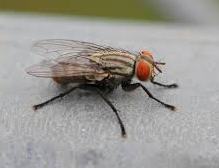Listen to this soothing song about flying away by John Denver and Olivia Newton John, who look impossibly young.
House flies are major carriers of disease. They are known to transfer over 100 pathogens resulting in ailments, including typhoid, tuberculosis, cholera and dysentery. House flies collect these pathogens on their legs and mouths when feeding on feces, trash and other decaying material.
The purpose: Although it may be hard to imagine what use a fly might possibly have, they actually play important roles in nature. A female housefly deposits about 100-150 eggs on something that can provide food for the larvae that will hatch from the eggs. This food typically consists of decaying material, such as garbage, animal droppings or grass clippings. Then, somewhere between 8 hours and 2 days later, the maggots hatch and begin to feed.

The fly has flown. Probably crawling over a drop of pineapple juice I spilled in the kitchen earlier. So far, I haven't been infected by one of the nasty diseases the housefly might carry on its legs. Might as well face facts: Flies like our bodies because of the salt and dead cells on our skin.
Winter suddenly seems appealing.

 RSS Feed
RSS Feed






